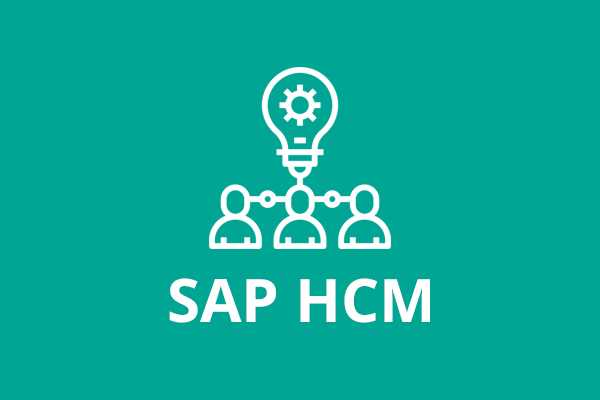SAP HCM (basic to advanced)
Learn about core HR processes in SAP HCM to significantly improve your workforce performance, improve planning accuracy, streamline HR processes. View Course Curriculum
Price Match Guarantee
Full Lifetime Access
Access on any Device
Technical Support
Secure Checkout
Course Completion Certificate
View Course Curriculum
Price Match Guarantee
Full Lifetime Access
Access on any Device
Technical Support
Secure Checkout
Course Completion Certificate
 72% Started a new career
BUY THIS COURSE (GBP 29)
72% Started a new career
BUY THIS COURSE (GBP 29)
-
 93% Got a pay increase and promotion
93% Got a pay increase and promotion
Students also bought -
-

- SAP HCM (Human Capital Management)
- 20 Hours
- GBP 29
- 2492 Learners
-

- SAP HCM Payroll
- 4 Hours
- GBP 29
- 121 Learners
-

- Bundle Multi (2-in-1) - SAP HCM
- 50 Hours
- GBP 49
- 346 Learners

SAP HCM (Human Capital Management) is one of the major modules in SAP that plays an important role in building an organized management in enterprises. SAP HCM consultants are some of the most demanded professionals in the global market.
SAP HCM provides a complete and integrated set of tools to help you effectively manage your people. With SAP HCM you can automate your core HR processes to significantly improve your workforce performance, improve planning accuracy, streamline HCM processes, cut operational costs and increase margins with meaningful talent intelligence. Post attending our HCM training, you can proceed ahead to become a SAP Certified Application Associate – Human Capital Management with SAP ERP 6.0 EHP4.
Because of the huge benefits of SAP HCM ERP software, most of the top companies are using the SAP HCM module, therefore the demand for SAP HCM trained and certified candidates has increased manifold. This is the reason why most of the working HR professionals, beginners, and many other SAP Functional and Technical consultants are motivated toward SAP HCM training.
Key components and functionalities of SAP HCM include:
1. Organizational Management: This component allows organizations to define their hierarchical structure, job positions, and reporting relationships. It helps manage the organizational framework and employee assignments.
2. Personnel Administration: SAP HCM's Personnel Administration module is responsible for managing employee master data, such as personal information, employment details, and work schedules.
3. Time Management: Time Management in SAP HCM enables companies to record and track employee working hours, leave requests, and absence management.
4. Payroll: The Payroll component handles the calculation of employee wages and salaries, taking into account various payroll elements, tax deductions, and benefits.
5. Talent Management: SAP HCM's Talent Management module covers recruitment, talent acquisition, performance management, employee development, and succession planning.
6. Employee Self-Service (ESS) and Manager Self-Service (MSS): SAP HCM provides web-based ESS and MSS portals that allow employees and managers to access and manage their HR-related data, request leaves, view pay slips, and perform other HR tasks.
7. Learning and Development: This component supports the creation and management of training programs and learning activities for employees' skill development.
8. Compensation Management: SAP HCM facilitates the management of employee compensation, including salary adjustments, incentives, and bonus calculations.
9. Travel Management: Travel Management in SAP HCM helps manage employee travel expenses, including travel requests, approvals, and reimbursement processing.
10. Personnel Development: This module focuses on employee competency and career development, providing tools to identify skill gaps and plan training interventions.
With this SAP HCM course by Uplatz, you will learn to:
1) Understand business from HR teams like Recruitment, Payroll, Timesheet etc.
2) Map customer business processes in SAP
3) Train users for using SAP system
4) Integrate HCM module with other functional areas like Finance, Sales etc.
5) Design/enhance operational and analytical reports for customer
You will be awarded a Course Completion Certificate by Uplatz at the end of the course.
Course/Topic - SAP HCM (basic to advanced) - all lectures
-
In this first video on the SAP HCM course, you will get a brief introduction to the contents of the course such as Pre-sales activities, the types of projects and the implementation projects, System landscape, support and maintenance, and others.
-
In this video, you will learn about the steps involved in the Implementation Project like the Project structure, Core team, Key users, Project Manager, and others along with the reporting structure of a project.
-
In this video, you will get a detailed explanation of the As-is business and what are the scenarios a user can go through while working on it. Furthermore, you will learn what are the different and step-by-step procedures of working with it and how it makes value to a business. You will be seeing the concepts being explained by the trainer in the SAP system.
-
In this session, you will understand what is Business blue print, the Organizational Management, the Organizational Unit, and the relationship between the 3 which will be shown in the SAP system.
-
In this video, you will learn about the concept of training being implemented in the SAP HCM module and the different levels of corporate training. You will further learn about the Integration Testing among cross modules, the Cutover activities, the support, and the concept of Ticket and Tool in HCM.
-
In this video, you will learn more concepts after completion of the Enterprise Structure in the previous lessons like defining Indicators in SAP HCM, Group Employee Subgroups for Time Quotas, Defining Counting Classes for Periodic Work Schedule and others. These concepts will be clearly shown by the trainer in the SAP system.
-
In this video, you will learn the different scenarios associated with Time Management for the HCM module like you will be taught to define the Break Schedule in the system, Executing Project, how to Add Entries in the SAP system for the HCM module, creating Work Schedule and others.
-
In this session, you will learn about the concept of Payroll in the SAP HCM module, starting with what is Payroll, what is SAP Period Parameter, how to create Period Parameter or PP, what is a Payroll Area and others. In shorts, you will be learning about the Basic Pay Customization.
-
In this video, you will learn about the 0014 Recurring payments and deductions, along with Creating Wage Type Catalog and how to work on it in the system. Further, you will be learning about Assigning Wage Types to Wage Type Groups, Checking Wage Type Text, Defining Deduction Periods, Specifying Default Values, and Defining Default Values for Payment Methods.
-
This tutorial is about Personnel Actions starting with what is Personnel Action, what is an info group, how to maintain list of infotypes, how to run Payroll, Action Type, Action Reason, changing of Action Menu, maintaining User Parameters and others. All these will be shown with a detailed explanation by the trainer in the SAP system.
-
In this tutorial, you will get a brief overview of the Organizational Structure along with the building elements. Moreover, you will also learn about the Organizational Unit, the kinds of Organizational Units, what are the primary Organizational Keys, and the kinds of Organizational Units. Furthermore, you will be learning how to customize the Organizational Structure and these all will be shown in the SAP system.
-
In this session, you will learn about the different modes in Organization Structure and its work process will be shown in the SAP system by the trainer with a detailed explanation of each and every mode. Along with this, you will also learn about the modes associated with Organization and Staffing.
-
In this session, you will get a brief overview of Schema, what are the main and sub schemas, and the whole work process will be shown in the SAP system by the trainer with a detailed and step-by-step implementation. Moreover, you will also learn how to run Payroll in the SAP system and what are the steps associated with it.
-
In this session, you will learn about the benefits, Infotypes, features, and some important terms associated with SAP HCM. Along with this, you will also learn about the Plan Category, Plan benefits, Parameters along with defining Benefit Area, Assigning Currency to Benefit Area, and Defining Benefit Providers and Defining Plan Types. All these will be shown by the trainer in the SAP system.
-
This video is a continuation to the Schema concept of the SAP HCM module where you will learn some more in-depth concepts of Main Schema and Sub Schema with an overview of its working mechanism in the SAP system.
-
This session is about Personnel Development which is a small but integral part of the SAP HCM module. Her, you will learn about the different skills for an employee which an organization looks in its employees, the position or role of the employee in the company, employee’s qualification and all these will be guided in the SAP system with a detailed implementation of the work process.
-
In this session, you will learn about the Training and Event Management whenever one goes for the implementation of the SAP product, the types of training to be conducted in the company, the resources and entries as shown in the system and others.
-
In this video, you will get a brief overview of Report like what is report, what are the types of report in SAP, a brief and detailed understanding of Standard and Customer Report and the complete work process will be shown in the SAP system.
-
In this session, you will be learning about the ASAP Methodology, why we should use ASAP, how many phases are there in the ASAP Methodology, and lastly, what are the roles of a functional consultant in each phase. Moreover, you will also be learning about the projects, under it the Implementation Project and others.
-
In this video, you will learn what is LSMW, why to use LSMW, what is the data one can upload, and what is the process associated it. This concept will also be shown in the SAP system by the trainer throughout the whole session.
-
This last video on the SAP HCM course is all about Defining Employee Grouping, what is its work process in the SAP system and how to implement it will be shown with a detailed explanation by the trainer in the SAP system.
• Basic understanding of SAP ERP Human Capital Management
• Overview of the main functionality of SAP ERP HCM
• SAP HCM Navigation and Terminology
• Business Processes and HCM Structures
• Step by Step Configuration
SAP HCM (basic to advanced) – Course Syllabus
1. Introduction:
a. ERP and ERP Packages
b. SAP and its architecture
c. SAP and its modules
d. SAP Human Capital Management (HR) and its areas
e. Discussions with Participants
2. Overview:
a. Getting Started
b. The HR module
c. Organizational Information
d. Employee Information
3. Recruitment and Personnel Development:
a. The recruitment cycle
b. Training and Events
c. Personnel Development
d. Hands On : Matching Profiles
4. Employee Benefits and Cost Management:
a. Benefits
b. Hands On: Processing an enrollment
c. Personnel Cost Planning
d. Compensation Management
5. Time Management, Payroll and Travel:
a. Time Management
b. Payroll
c. Hands On: Running a payroll
d. Travel Management
6. Information Display and Reporting:
a. Human Resources Reports
b. Queries
c. Hands On: Creating an ad hoc query
7. Organization Management:
a. Introduction to Organization Management
b. Organizational Objects and designing Organization Structure
c. Organization Units, Positions, Jobs, Tasks, Reporting structure
d. Different interfaces of Organization Management
e. Organization and Staffing
f. General Structures
g. Matrix Structures
h. Expert mode Simple Maintenance
i. Expert mode Info type Maintenance
8. Configuring an Organizational Structure:
a. Create Objects
b. Essential Relationships
c. Create Description
d. Create Department/Staff
e. Add Relationships
f. Maintain Plan Data
g. Add account assignment to the company organizational unit
h. Account assignment features
i. Structure Maintenance
9. Configuring Positions:
a. Configure Positions
b. Configure Reporting Relationships
c. Produce an Organizational Structure Report
10. Executing a Personnel Action:
a. Hire an Employee
b. Make changes to Employee Master Data
c. Produce an Employee List report for the new employee
11. Using the Implementation Guide (IMG):
a. Create a Project Plan
b. Generate a project IMG
c. Description of Vacant Position
d. Use the "find" feature to locate IMG activities
e. Execute IMG activity
f. Maintain status of project activities
12. Establishing the Enterprise Structure:
a. Configuring Personnel Sub-Areas
b. Employee Sub-groups
c. Grouping for Work Schedules
13. Additional Organizational Assignments:
a. Maintain HR Master Data
b. Change Organizational Assignment
14. Using Features:
a. Display Features
b. Process Feature Decision Tree
15. Understanding Planned Working Time Connection to Basic Pay:
a. Display the HR Master Data
b. Planned Working Time
c. Basic Pay
d. Work Schedules Overview , Primary Wage Type and Employee Groupings
16. Defining Payscale Structures:
a. Customizing Project Administration
b. Process Feature Tariff: Decision Tree
c. Choose Activity
d. Change Payscale-period parameter assignment
e. Determine work area
f. Create Basic Pay
17. Defining Wage Types:
a. Create Dialog Wage Type
b. Understand Controls used to determine wage type assignment
c. Define feature LGMST to default wage type assignment
d. Setup indirect valuation
18. Performing Payscale reclassification and Pay increases:
a. Understand how to perform payscale reclassifications
b. Configure a payscale reclassification to a new payscale level after employees have been in a payscale level for one year
c. Understand how to perform standard pay increases
19. Confirming the new master data configuration:
a. Modify an existing organizational structure to add a new organizational unit and new position
b. Process a hire personnel action and confirm the functionality of the newly configured personnel subarea, employee subgroup, payscales and wage types.
20. Quick Tips:
a. Completing an Action
b. Maintaining Free Text
c. Time Off Award
d. Creating Positions
e. Changing Cost Centers
f. Changing Bank Details
g. Recurring Payments and Deductions
h. Changing Addresses
i. Viewing Organizational Structure
j. Changing Work Rule
k. Date Types
l. Kronos Information
m. Preparing for an Interview with SAP HCM Consultant.
The SAP HCM (basic to advanced) Certification ensures you know planning, production and measurement techniques needed to stand out from the competition.
It helps in automating all the basic tasks related to employee and personnel information management. Uses a centralized database for enabling employees and others in the management to access consistent, up-to-date, information to provide support to business-related decisions.
An Enterprise Resource Planning platform, or ERP software system, is primarily used for businesses who need to integrate and establish a means of communication between departments to share data and other workflows with one another.
There will be continuous demand of SAP HCM consultants but addition of knowledge on above said technologies, will be an added advantage. Knowledge of multiple technologies in SAP space is in demand because of complex business requirements. Open SAP and SAP SCN are good sources where we can improve our knowledge.
Oracle Cloud brings together ERP and HCM on one cloud platform with a common data model. Having a single employee record across finance and HR streamlines processes, eliminates redundancy, and reduces errors.
Uplatz online training guarantees the participants to successfully go through the SAP HCM (basic to advanced) Certification provided by Uplatz. Uplatz provides appropriate teaching and expertise training to equip the participants for implementing the learnt concepts in an organization.
Course Completion Certificate will be awarded by Uplatz upon successful completion of the SAP HCM (basic to advanced) online course.
The SAP HCM (basic to advanced) draws an average salary of $112,000 per year depending on their knowledge and hands-on experience.
Oracle's Enterprise Performance Management (EPM) Cloud provides complete business solutions for financial close processes, operational and resource planning, forecasting, and budgeting.
Oracle ERP is a cloud-based software solution used to automate back office processes and day–to-day business activities. It is a business management software suite that includes financial management, supply chain management, project management, accounting, and procurement.
There will be continuous demand of SAP HCM consultants but addition of knowledge on above said technologies, will be an added advantage. Knowledge of multiple technologies in SAP space is in demand because of complex business requirements. Open SAP and SAP SCN are good sources where we can improve our knowledge.
Note that salaries are generally higher at large companies rather than small ones. Your salary will also differ based on the market you work in.
SAP HCM Payroll Consultant.
SAP SF / HCM – Manager.
SAP HCM Consultant.
Q1) List The Various Components Of The Enterprise Structure In Systems, Applications, And Products (SAP) In Human Capital Management (HCM)?
Ans: The components of the enterprise structure in SAP HCM are given as follows:
· Client
· Company code
· Personnel area
· Personnel subarea
Q2) What Is Client In The SAP System?
Ans: In the SAP R/3 (R stands for Real-time) system, a client is an organization and a legal entity. A client is positioned at the highest level among all the organizational units. It contains the master data of various business processes, such as customers, products, and vendors. A three-digit number is used to represent clients in the SAP R/3 system.
Q3) What Is the Company Code?
Ans: A company code is a unique four-character alphanumeric code that represents a legally independent enterprise.
Q4) What Is Personnel Area?
Ans: A personnel area is a subunit of the company code. It is identified as an organizational unit representing an area in an enterprise, which is organized according to personnel administration, time management, and payroll accounting criteria. It is represented as a four-character alphanumeric code. For example, the personnel area code for a corporation is CORP.
Q5) What Are Personnel Subareas?
Ans: A personnel subarea is a part of the personnel area, which can be subdivided according to the geographical location or the strategic line of business. It is represented as a four-character alphanumeric code. For example, if the branches or locations of an organization are defined as personnel areas, then its departments, such as HR and ADMIN, are the personnel subareas of the organization.
Q6) What Is SAP HCM Workflow?
Ans: The SAP HCM Workflow automates business processes and assigns tasks to appropriate persons at the right time.
Q7) What Do You Mean By Info types In SAP HCM?
Ans: Info types are referred to as system-controlled characteristics of employees. Information related to an employee is stored in the form of Infotypes,
Q8) which are represented by a four-digit numeric code given as follows:
Ans:
· 0000 for actions
· 0001 for organizational assignment
· 0002 for personal data
· 0003 for payroll status
Q9) What Are Features In SAP HCM?
Ans: Features are decision trees customized in the Implementation Guide (IMG) screen in SAP HCM that are made up of technical fields whose values are defaulted in the easy access.
Q10) How Do You Hire A New Employee?
Ans: A new employee is hired with the PA40 transaction code. After that, all the Infotypes are maintained for the employee by using the PA30 transaction code.
Q11) What are the three administrators?
Ans: The three administrators are :
· Personnel Administrator
· Payroll Administrator
· Time Administrator
Q12) How does any company use an organizational plan?
Ans: The company organization structure and reporting structure are represented through the organization plan. The active plan version is the current plan version and the other plan versions are considered as various planning Stages. Used for manpower planning. Normally plan version"01" is always made the active plan version.
Q13) What is an evaluation path?
Ans: An evaluation path describes a chain of relationships that exists between individual organizational objects in the organizational plan.
You can maintain evaluation paths on img -> Personnel Management ->Organization Management-> Basic Settings-> Maintain Evaluation Paths .
Q14) What is the difference between a job and a position?
Ans: Job is not concrete, it is generic. (Eg: Manager, Assistant Manager, Consultant). Positions are related to persons. The position is concrete and specific which is occupied by Persons. (Eg: Manager – Finance, Consultant – SAP HR).
Q15) What are Dynamic Actions? Give a few examples?
Ans: Dynamic actions when triggered by the system. They are the result of some personnel actions. If changes are made (personnel action) to the personnel data of an info type, then has an effect on the data of a second info type, the system automatically displays the info type. One of the main purposes of the dynamic action (of the system) is to have consistent and coherent data. These actions are started automatically by the system, unlike the Personnel actions which you start by yourself. The best example is when an action is carried out like hiring; it needs to populate a set of info types. In the initial entry of details in info type 0000 is personnel action. Then the system automatically displays the next info types- which are the result of dynamic action.









